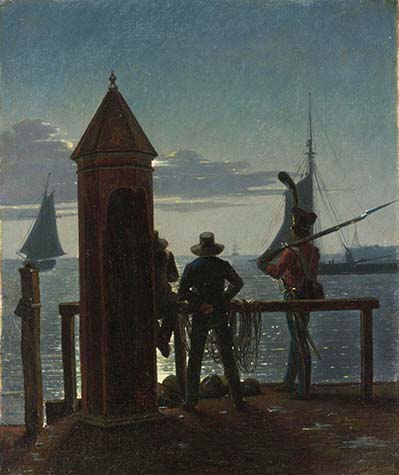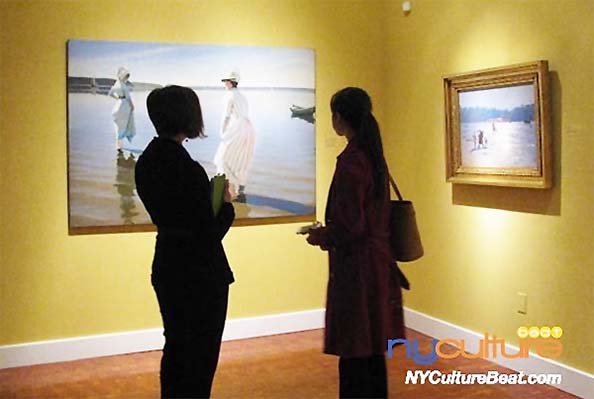메트뮤지엄(NY), 게티센터(LA) 19세기 덴마크 회화전 'Beyond the Loght'

Beyond the Light: Identity and Place in Nineteenth-Century Danish Art
The Met to Explore Notions of Identity and Place in Nearly 100 Works of 19th-Century Danish Art
*The Met Exhibition Dates: January 26–April 16, 2023
Exhibition Location: The Met Fifth Avenue, Galleries 691–693,
*Getty Center in Los Angeles from May 23 to August 20, 2023.
Beyond the Light: Identity and Place in Nineteenth-Century Danish Art examines the period formerly known as the Danish Golden Age, a name that belies the economic and political hardships Denmark experienced in the 19th century. Yet this turmoil is what gave rise to a vibrant cultural and philosophical environment with a close-knit community of Danish artists inspired to explore notions of place, identity, and belonging in their work. Opening at The Metropolitan Museum of Art on January 26, Beyond the Light places the drawings, oil sketches, and paintings created by these artists firmly in this period, one that witnessed the transformation of a once-powerful Danish kingdom into a small, somewhat marginalized country at the edge of Europe.
The exhibition is made possible by Gilbert and Ildiko Butler.
Additional support is provided by The Schiff Foundation.
The exhibition is organized by The Metropolitan Museum of Art and the J. Paul Getty Museum, in collaboration with SMK – The National Gallery of Denmark.
“Beyond the Light tells a powerful story about shifting borders, national identity, and feelings of belonging and displacement—all themes that resonate with contemporary audiences all over the world,” said Max Hollein, Marina Kellen French Director of The Met. “By focusing mainly on drawings and oil sketches of the period, the exhibition is the first to offer a history of 19th-century Denmark that is more personal and nuanced than the more official one often represented by finished paintings.”
The exhibition features approximately 100 works from The Met collection, SMK – The National Gallery of Denmark, several American public collections, and the private collection of Roberta Olson and Alexander Johnson. It highlights such artists as Christoffer Wilhelm Eckersberg, Christen Købke, Constantin Hansen, Martinus Rørbye, and Vilhelm Hammershøi as well as lesser-known figures like Anton Melbye, Johan Thomas Lundbye, Peter Christian Skovgaard, and Heinrich Gustav Ferdinand Holm, among others.
Exhibition Overview
The 19th century was one of the most tumultuous periods in Denmark’s history—from the disaster of the Napoleonic Wars and the devastating bombardment of Copenhagen to subsequent bankruptcy and mounting antagonism with Germany. Denmark also went from being one of the oldest absolute monarchies with a thousand-year history to a constitutional democracy. Efforts to restore the nation’s psyche led to a rise in nationalism and, with it, an increased interest in Danish history, customs, culture, and language. This exhibition unfolds in five thematic sections—with an unprecedented focus on drawings—to explore the art of this period as Danish artists navigated a rapidly changing world.
Upon approaching the galleries, visitors will encounter the beautiful Danish landscape through a dramatic, blown-up version of Christoffer Wilhelm Eckersberg’s expansive Panorama of the Copenhagen Roads (from SMK’s collection) on the outer walls of the exhibition. In this sweeping vista drawn across five sheets of paper, Eckersberg depicts a peaceful view of fishing villages, gardens, forests, harbors, and mills, while also including military batteries and other markers of conflict.
As Denmark’s borders diminished drastically and traditional power structures eroded, Danish artists contemplated their identity and how best to portray themselves and their fellow Danes. The exhibition’s first section features portraits of individual and groups of artists, such as Constantin Hansen’s A Group of Danish Artists in Rome (SMK), demonstrating the strong community working together both at home and abroad. A tension between idealism and realism is evident in many of the portraits from this troubled moment in Denmark’s history, including Johan Vilhelm Gertner’s Portrait of Bertel Thorvaldsen (Olson-Johnson Collection) and Christen Købke’s Portrait of Professor Frederik Christian Sibbern (SMK).
The second section explores how Danish artists portrayed their immediate surroundings and played a part in the growing nationalist movement. Denmark’s first art historian, the ardent nationalist Niels Laurits Høyen, believed that his country’s identity was tied to its distinctive landscape and material culture. He taught at the Royal Danish Academy of Fine Arts, organized the Fine Arts Society, and transformed the Royal Collection into a national museum, among other initiatives. After extensive travel through Europe, Høyen embraced the movement to preserve Danish monuments as symbols of national cultural heritage. In response, Danish artists began to draw and paint their country’s cultural, religious, military, and political monuments. Examples include Johan Christian Dahl’s Copenhagen Harbor by Moonlight (The Met), Købke’s Roof Ridge of Frederiksborg Castle with View of Lake, Town and Forest (SMK), and Martinus Rørbye’s Viborg, seen from Asmild Klosterhave near Søndersø (SMK).
The exhibition’s third section takes the artists outside the recognizable edifices of their society and into the forested landscapes, where they explore ideas of time and history. Denmark’s scenery underwent rapid changes in the 19th century due to the effects of industrialization, agricultural expansion, and urban growth. Many Danes, worried they were witnessing the destruction of their homeland, sought to understand their past before irreplaceable traces of it were erased. Danish artists recorded these traces of the ancient world by venturing out into the landscape and observing geological, topographical, and archaeological features—from Johan Thomas Lundbye’s depiction of a Stone Age dolmen at sunset (The Morgan Library & Museum) to Peter Vilhelm Carl Kyhn’s oil sketch of the Kalvebod Strand (Olson-Johnson Collection). Many of the drawings and painted studies from this period were executed on location and are characterized by a heightened awareness of humanity’s connections to and interactions with its surroundings.
Denmark’s picturesque coastline and long maritime history were a source of inspiration for 19th-century Danish artists. The ever-changing sea became an important symbol of national security and pride, especially in the Royal Danish Navy and Danish merchant fleet, as well as a place of adventure, history, and exploration and a means of past and future prosperity. The exhibition’s fourth section consists of pictures exploring the country’s relationship to the water, such as Eckersberg’s Anchors in a Copenhagen Square (SMK), and Anton Melbye’s The English Fleet Anchored at the Town of Beykoz, North of Istanbul (The Met). Another highlight, Rørbye’s romantic painting of Copenhagen’s harbor, titled View from the Citadel Ramparts in Copenhagen by Moonlight (The Met), captures a moment of calm at the formidable but battered citadel amid a time of national upheaval.
The final section moves across the sea to the lands beyond Denmark, as the artists experienced the people and places of Germany, France, Italy, Greece, and Turkey. The Royal Danish Academy, where most 19th-century Danish artists trained, considered a journey abroad integral to an artist’s education. In addition to visiting museums, galleries, and artists’ studios, students were urged to examine the architectural ruins of ancient Rome, and many worked en plein air, or outdoors, for the first time. These drawings and oil sketches reflect the people, customs, architecture, and landscape that the artists experienced during their travels—from Købke’s The Forum, Pompeii, with Vesuvius in the Distance (J. Paul Getty Museum) to Peter Christian Skovgaard’s Olevano (Olson-Johnson Collection)—while speaking to ideas of home, belonging, and travel and return.
Credits and Related Content
Beyond the Light: Identity and Place in Nineteenth-Century Danish Art is organized by guest curator Freyda Spira (former Associate Curator in the Department of Drawings and Prints at The Met and current Robert L. Solley Curator of Prints and Drawings at Yale University Art Gallery), in collaboration with Stephanie Schrader (Curator of Drawings, J. Paul Getty Museum), and Thomas Lederballe (Chief Curator, Senior Researcher, SMK – The National Gallery of Denmark).
Following The Met’s presentation, the exhibition will be on view at the Getty Center in Los Angeles from May 23 to August 20, 2023.
A fully illustrated catalogue accompanies the exhibition. Published by The Metropolitan Museum of Art and distributed by Yale University Press, it is available for purchase from The Met Store.
Image: Martinus Rørbye (Danish, Drammen 1803–1848 Copenhagen). View from the Citadel Ramparts in Copenhagen by Moonlight, 1839. Oil on canvas. 11 3/8 x 9 5/8 in. (28.9 x 24.4 cm). The Metropolitan Museum of Art, New York, Gift of Eugene V. Thaw, 2007 (2007.164.7)

*'디자인 왕국' 덴마크의 회화들@스칸디나비아 하우스, 2013
https://www.nyculturebeat.com/index.php?document_srl=2924384&mid=Art2




 브라질 컬렉터, 반고흐 여동생 모델 회화 소유권 주장, 디트로이...
브라질 컬렉터, 반고흐 여동생 모델 회화 소유권 주장, 디트로이...

